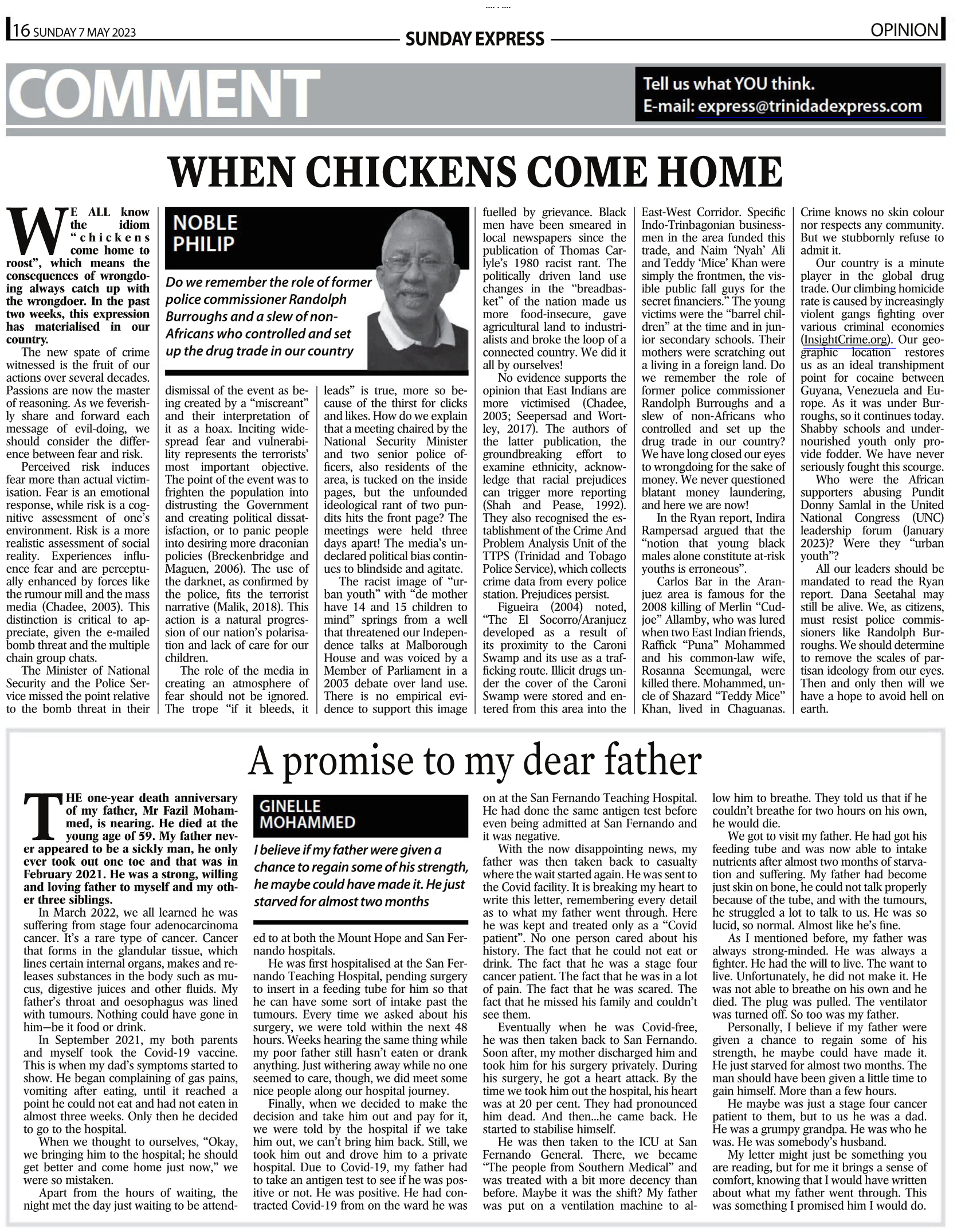When chickens come home
WE ALL know the idiom 'chickens come home to roost', which means the consequences of wrongdoing always catch up with the wrongdoer. In the past two weeks, this expression has materialised in our country.
The new spate of crime witnessed is the fruit of our actions over several decades. Passions are now the master of reasoning. As we feverishly share and forward each message of evil-doing, we should consider the difference between fear and risk.
Perceived risk induces fear more than actual victimisation. Fear is an emotional response, while risk is a cognitive assessment of one's environment. Risk is a more realistic assessment of social reality. Experiences influence fear and are perceptually enhanced by forces like the rumour mill and the mass media (Chadee, 2003). This distinction is critical to appreciate, given the e-mailed bomb threat and the multiple chain group chats.
The Minister of National Security and the Police Service missed the point relative to the bomb threat in their dismissal of the event as being created by a 'miscreant' and their interpretation of it as a hoax. Inciting widespread fear and vulnerability represents the terrorists' most important objective. The point of the event was to frighten the population into distrusting the Government and creating political dissatisfaction, or to panic people into desiring more draconian policies (Breckenbridge and Maguen, 2006). The use of the darknet, as confirmed by the police, fits the terrorist narrative (Malik, 2018). This action is a natural progression of our nation's polarisation and lack of care for our children.
The role of the media in creating an atmosphere of fear should not be ignored. The trope 'if it bleeds, it leads' is true, more so because of the thirst for clicks and likes. How do we explain that a meeting chaired by the National Security Minister and two senior police officers, also residents of the area, is tucked on the inside pages, but the unfounded ideological rant of two pundits hits the front page? The meetings were held three days apart! The media's undeclared political bias continues to blindside and agitate.
The racist image of 'urban youth' with 'de mother have 14 and 15 children to mind' springs from a well that threatened our Independence talks at Malborough House and was voiced by a Member of Parliament in a 2003 debate over land use. There is no empirical evidence to support this image fuelled by grievance. Black men have been smeared in local newspapers since the publication of Thomas Carlyle's 1980 racist rant. The politically driven land use changes in the 'breadbasket' of the nation made us more food-insecure, gave agricultural land to industrialists and broke the loop of a connected country. We did it all by ourselves!
No evidence supports the opinion that East Indians are more victimised (Chadee, 2003; Seepersad and Wortley, 2017). The authors of the latter publication, the groundbreaking effort to examine ethnicity, acknowledge that racial prejudices can trigger more reporting (Shah and Pease, 1992). They also recognised the establishment of the Crime And Problem Analysis Unit of the TTPS (Trinidad and Tobago Police Service), which collects crime data from every police station. Prejudices persist.
Figueira (2004) noted, 'The El Socorro/Aranjuez developed as a result of its proximity to the Caroni Swamp and its use as a trafficking route. Illicit drugs under the cover of the Caroni Swamp were stored and entered from this area into the East-West Corridor. Specific Indo-Trinbagonian businessmen in the area funded this trade, and Naim 'Nyah' Ali and Teddy 'Mice' Khan were simply the frontmen, the visible public fall guys for the secret financiers.' The young victims were the 'barrel children' at the time and in junior secondary schools. Their mothers were scratching out a living in a foreign land. Do we remember the role of former police commissioner Randolph Burroughs and a slew of non-Africans who controlled and set up the drug trade in our country? We have long closed our eyes to wrongdoing for the sake of money. We never questioned blatant money laundering,
and here we are now!
In the Ryan report, Indira Rampersad argued that the 'notion that young black males alone constitute at-risk youths is erroneous'.
Carlos Bar in the Aranjuez area is famous for the 2008 killing of Merlin 'Cudjoe' Allamby, who was lured when two East Indian friends, Raffick 'Puna' Mohammed and his common-law wife, Rosanna Seemungal, were killed there. Mohammed, uncle of Shazard 'Teddy Mice' Khan, lived in Chaguanas. Crime knows no skin colour nor respects any community. But we stubbornly refuse to admit it.
Our country is a minute player in the global drug trade. Our climbing homicide rate is caused by increasingly violent gangs fighting over various criminal economies (InsightCrime.org). Our geographic location restores us as an ideal transhipment point for cocaine between Guyana, Venezuela and Europe. As it was under Burroughs, so it continues today. Shabby schools and undernourished youth only provide fodder. We have never seriously fought this scourge.
Who were the African supporters abusing Pundit Donny Samlal in the United National Congress (UNC) leadership forum (January 2023)? Were they 'urban youth'?
All our leaders should be mandated to read the Ryan report. Dana Seetahal may still be alive. We, as citizens, must resist police commissioners like Randolph Burroughs. We should determine to remove the scales of partisan ideology from our eyes. Then and only then will we have a hope to avoid hell on earth.
Photo: NOBLE PHILIP
Do we remember the role of former police commissioner Randolph Burroughs and a slew of non-Africans who controlled and set up the drug trade in our country

